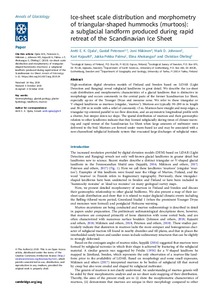Ice-sheet scale distribution and morphometry of triangular-shaped hummocks (murtoos): a subglacial landform produced during rapid retreat of the Scandinavian Ice Sheet
Mark D. Johnson; Kari Kajuutti; Elina Ahokangas; Jukka-Pekka Palmu; Antti E. K. Ojala; Joni Mäkinen; Christian Öhrling; Gustaf Peterson
https://urn.fi/URN:NBN:fi-fe2021042825196
Tiivistelmä
High-resolution digital elevation models of Finland and Sweden based on LiDAR (Light
Detection and Ranging) reveal subglacial landforms in great detail. We describe the ice-sheet
scale distribution and morphometric characteristics of a glacial landform that is distinctive in
morphology and occurs commonly in the central parts of the former Scandinavian Ice Sheet,
especially up-ice of the Younger Dryas end moraine zone. We refer to these triangular or
V-shaped landforms as murtoos (singular, ‘murtoo’). Murtoos are typically 30–200 m in length
and 30–200 m in width with a relief of commonly <5 m. Murtoos have straight and steep edges, a
triangular tip oriented parallel to ice-flow direction, and an asymmetric longitudinal profile with
a shorter, but steeper down-ice slope. The spatial distribution of murtoos and their geomorphic
relation to other landforms indicate that they formed subglacially during times of climate warming and rapid retreat of the Scandinavian Ice Sheet when large amounts of meltwater were
delivered to the bed. Murtoos are formed under warm-based ice and may be associated with a
non-channelized subglacial hydraulic system that evacuated large discharges of subglacial water
Kokoelmat
- Rinnakkaistallenteet [19207]
